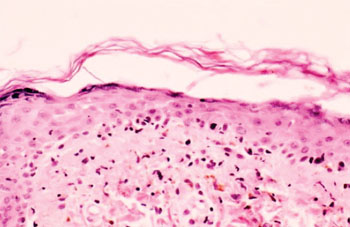Test Predicts Treatment Response to Leukemia Stem Cell Transplants
By LabMedica International staff writers
Posted on 07 Jan 2015
A new test may reveal which patients will respond to treatment for graft versus host disease (GVHD), an often life-threatening complication of stem cell transplants used to treat leukemia and other blood disorders.Posted on 07 Jan 2015
Patients with fatal blood cancers like leukemia often require allogenic stem cell transplants (SCT) to survive and when these donor stem cells are transplanted to a recipient, there is a risk of developing GVHD, a life-threatening complication and major cause of death after SCT.

Image: Histology of chronic inflammation of upper dermis with perivascular lymphocytic infiltrate and intraepidermal lymphocytes from a patient with graft versus host disease (Photo courtesy of Dr. Amy Lynn).
Scientists at the Icahn School of Medicine at Mount Sinai (New York, NY, USA) working with a multicenter team, developed and tested a new scoring system using almost 500 patient blood samples with newly diagnosed GVHD in varying grades from two different centers between April 13, 2000, and May 7, 2013. They used three validated biomarkers, tumor necrosis factor receptor 1 (TNFR1), suppression of tumorigenicity 2 (ST2) and regenerating gene family protein 3α (Reg3α), to create an algorithm that calculated the probability of non-relapse mortality that is usually caused by GVHD that provided three distinct risk scores to predict the patient's response to GVHD treatment.
The algorithm was evaluated in a validation set of 300 additional patients from twenty different SCT centers throughout the USA. The algorithm worked perfectly, and the cumulative incidence of non-relapse mortality significantly increased as the GVHD score increased, and so the response rate to primary GVHD treatment decreased. The biomarker-based scores can be used to guide risk-adapted therapy at the onset of acute GVHD. High risk patients with a score of three are candidates for intensive primary therapy, while low risk patients with a score of one are candidates for rapid tapering of systemic steroid therapy.
James L. M. Ferrara, MD, DSc, a senior author of the study, said, “This new scoring system will help identify patient who may not respond to standard treatments, and may require an experimental and more aggressive approach. It will also help guide treatment for patients with lower-risk GVHD who may be over-treated. This will allow us to personalize treatment at the onset of the disease. Future algorithms will prove increasingly useful to develop precision medicine for all SCT patients.” The study was published on December 23, 2014, in the journal the Lancet Hematology.
Related Links:
Icahn School of Medicine at Mount Sinai







 assay.jpg)






